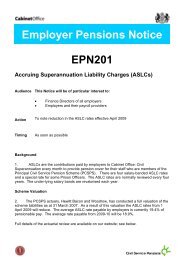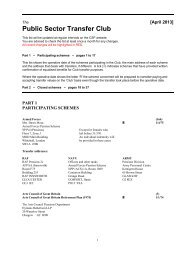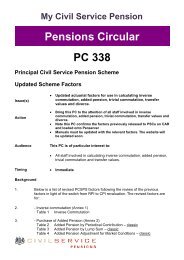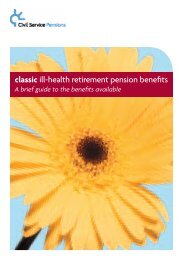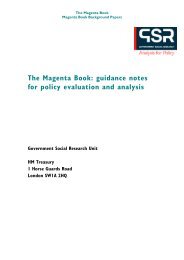Making Car Sharing and Car Clubs Work - Case ... - The Civil Service
Making Car Sharing and Car Clubs Work - Case ... - The Civil Service
Making Car Sharing and Car Clubs Work - Case ... - The Civil Service
You also want an ePaper? Increase the reach of your titles
YUMPU automatically turns print PDFs into web optimized ePapers that Google loves.
MAKING CAR SHARING AND CAR CLUBS WORKCASE STUDY SUMMARIESbelow, reveal that prior to the move a total of 9% of employees already car shared for workjourneying, while 12% indicated they were likely to choose this option after relocation. Singleoccupancy car use was due to drop from 62% to 56%. Of note, the move would also promptan increase in the proportion of those using bikes (from 8% to 11%), motor cycles (from 2%to 3%), <strong>and</strong> bus users (from 2% to 5%).3.9 <strong>The</strong> findings from this survey will be compared with an ‘after’ survey, due to take placeduring autumn 2004, which will reveal what, in practice, has been the effect of the travelmanagement measures introduced as a result of relocation.3.10 Overall, the effect of the scheme has been to encourage car park space sharing, rather thanvehicle sharing. A typical arrangement would be two drivers sharing one space, with eachentitled to use it, on average, two <strong>and</strong> a half days a week. On the non space days a driverwould use other means of transport, park <strong>and</strong> ride facilities, or not travel at all as they havecondensed their working week using flexitime arrangements. Those that do best out of thescheme are those in job share arrangements, who space share with their job share.Successes / Failures3.11 Key successes:Detailed <strong>and</strong> thorough consultation with staff <strong>and</strong> unions, which helped produce <strong>and</strong>refine an acceptable <strong>and</strong> workable scheme.<strong>The</strong> development <strong>and</strong> successful implementation of the scheme in a large <strong>and</strong> diverseorganisation demonstrated good practice in change management. GCHQ intends touse the lessons learnt from this process in others areas of business management <strong>and</strong>its evolution.3.12 Teething problems:“GCHQ employs a lot of clever people whose job it is to find a way round seeminglyimpregnable systems. When some of them started applying their intellectualcapabilities to potential undermining of the rainbow parking system, cracks in thesystem became apparent. For example, there was a concern that frequent car usersmight ask a colleague who usually cycles to work to sign up with them for a yellowspace – sometimes as a favour, sometimes for a cash reward. <strong>The</strong> driver would havethe nominally shared space to themselves, while the cyclist continued to cycle –perhaps with a few extra quid in his pocket.” To address this problem the changemanagement team sought, <strong>and</strong> won, Cabinet Office approval to offer a one-offincentive payment for GCHQ staff to join – <strong>and</strong> stay in – the green parking allocationcategory. <strong>The</strong> payment is £400, based on the cost of a local bus season ticket, <strong>and</strong> istaxable.GCHQ purchased Jambusters software to help staff identify car share partners. Inpractice this worked well for matching those who live near each other, but was notsufficiently adaptable to enable drivers to identify potential partners on their route towork. Owing to the specialist nature of its staff GCHQ draws from a very widegeographical area. “We have people commuting to Cheltenham from Birmingham, evenNottingham.” GCHQ went back to the software designers <strong>and</strong> asked if they could refineFinal V1.1, Dec. 2004 - 16 -






